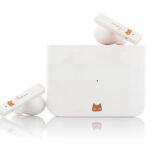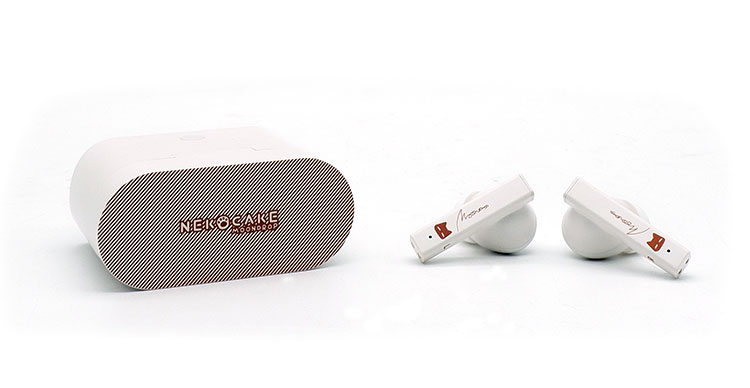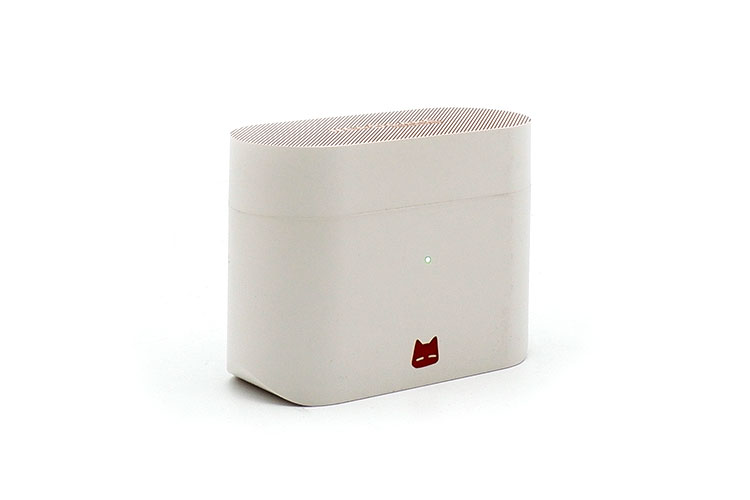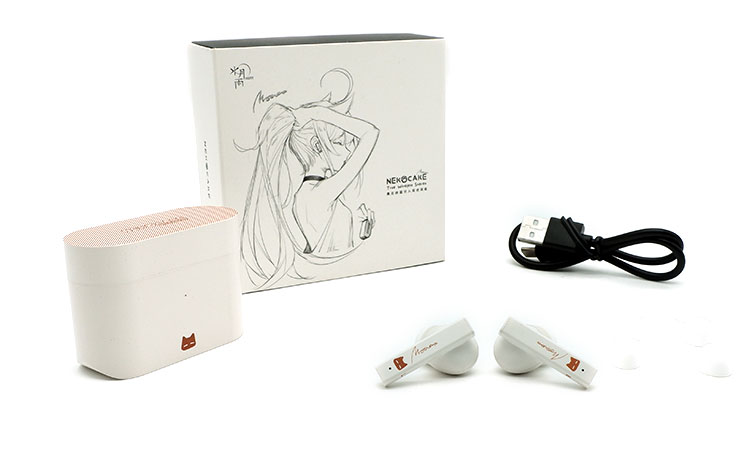Today’s feature is a review of the Moondrop Nekocake, which is an entry-level TWS offering active noise canceling, Bluetooth 5.0, and a new companion app. It is priced at $42.99
Disclaimer: This was sent to us as a sample for our honest opinion. Headfonics is an independent website with no affiliate links or services. We thank the team at Moondrop and Shenzhen Audio for giving us this opportunity.
To read more about Moondrop products we have previously covered on Headfonics, click here.
Note, this article follows our latest scoring guidelines which you can read up on here.
Last year, Moondrop dipped its toes into the TWS space with the release of its Sparks edition, which is a relatively affordable TWS system with app integration.
Now, they have taken it even further by releasing an even more affordable pair of TWS earbuds called the Nekocake that has a similar set of features to the Sparks, at least on paper.

Tech Highlights
It would be easy to assume that the Nekocake will be a stripped-down pair of earbuds due to its price. However, it’s surprising to see that Moondrop didn’t leave much out of this pair of TWS earbuds.
It features a 13mm dynamic driver that implements some of the core technologies that are used by most other Moondrop products with a pair of titanium dome composite diaphragms, and a Daikoku ultra-thin CCAW voice coil.
The connectivity options on the Nekocake are also relatively up to date with Bluetooth 5.0 capability and compatibility with both the SBC and AAC codecs allowing for connection to both Android and Apple devices. Furthermore, the Nekocake also features ANC modes that will cancel outside noise using the onboard microphones.
Aside from these standard features, the Nekocake also features software controls that will allow customization of both the EQ and touch controls using the Moondrop link app.
Design
Earbuds
Unlike most TWS earbuds that are shaped like an IEM shell, the Nekocake has stems similar to the ones that can be found with Apple Airpods. This allows the Nekocake to have a smaller shell and a smaller nozzle designed to ensure that it would fit even more ears, while the touch surface area is larger than most.
While most stems on TWS earbuds are round, the ones on the Nekocake are square, which makes it move around less when it’s inside the carrying case. This makes it easier to ensure that the contacts on each earbud connect securely to the charging pins on the carrying case using the magnets that are in both the earbuds and the carrying case.
Carrying Case
When looking at the carrying case for the Nekocake, it’s a design that unmistakably passed on from its stablemate, the Sparks, with its tall and wide dimensions. However, it is still compact enough to carry around at all times.
There is also a strong complementary themed color with the carrying case closely matching the earbuds. Both are made of smooth white plastic with rose gold accents.
Aside from the flip top of the carrying case, the Nekocake’s carrying case also features an LED that serves as the status display.
At the back of the carrying case, there is a button that can be used to activate the different functions of the carrying case. Interestingly, the USB port on the carrying case is located at the bottom of the case, which means that the case needs to be laid down before it can be charged.
Controls
Earbuds
The Nekocake has most of the standard controls that are typical to TWS earbuds. With a single tap on either side working as play/pause, a double tap on the left will be the previous track, and a double-tap on the right will be the next track.
Triple taps on the other hand will activate the voice assistant, and then pressing and holding for 2seconds will toggle the ANC mode.
The Nekocake also took the Moondrop’s cute anime girl packaging theme to the next level by also using the sound of the anime girl for the voice prompts when using the earbud controls. My only gripe with this is that the voice prompt could be clearer when saying ANC On and ANC Off, as these almost sound interchangeable when the voice prompt comes up.
Carrying Case
Something that I don’t always find with most other TWS earbuds is a multi-function button on the carrying case. This button will indicate the battery life with a single tap, and a green LED in front will turn on to indicate that there is more than a 10% charge left. Also, the LED will turn orange once the battery in the carrying case goes below 10%.
Pressing the multi-function button for 3 seconds while the TWS earbuds are in the case will bring the earbuds into pairing mode allowing a new device to connect to it. Pressing the multi-function button for 10 seconds on the other hand will reset the Nekocake back to the factory default settings, deleting all the previously paired devices.
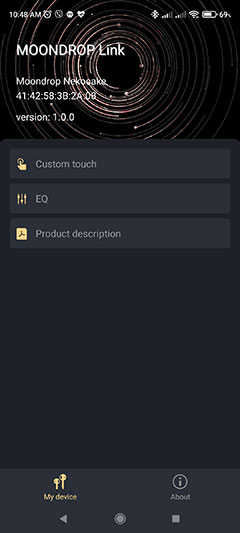
Moondrop Link
Instead of relying on the Hiby Blue app like was previously done with their Sparks, Moondrop opted to develop their own software for the Nekocake which they call Moondrop Link. The software is generally stable, though some words lack proper translation while other parts of the software come out in Chinese.
Inside the software, there are available options for EQ and control customization while there isn’t much in the way of status indication. With the EQ customization, there are just 5 modes by default, which are Balanced, Moondrop Classic, X’ Dynamic, ‘Nobass’, and ‘Wennebostel’.
Touch controls on the other hand can be customized by changing what gestures correspond to the controls on the Nekocake. Glaringly absent though are volume controls, so I end up having to reach for my phone when I need to change the volume.
Comfort & Isolation
Each earbud on the Nekocake is designed with a smaller shell with a narrow and short nozzle. This makes the Nekocake a generally comfortable pair of TWS earbuds, as it won’t intrude too much into my ears making it easy to have longer listening sessions with them. Despite the shallow insertion, the earbuds manage to stay secure inside my ears while I move around.
However, the smaller shell and the less intrusive ear tips ensure that there isn’t much passive isolation to speak of. Fortunately, the Nekocake is equipped with ANC modes, which is quite effective in canceling most of the low-frequency noise around me while giving me a feeling that there is some suck out of the sound in my ears.
Battery Life
Based on the specs sheet, the Nekocake can last up to 4 hours with each charge, while the charging case will add another 8 hours for a total of 12 hours of playing time.
However, with my testing, I was only able to get around 3 hours per full charge while having ANC on, and listening to moderate volume levels for each full charge of the earbuds.
Packaging & Accessories
While the Nekocake itself doesn’t look like there were particularly tight budget constraints when it was designed, the same cannot be said about the packaging and accessories. The Nekocake arrives in a simple box with an outer sleeve with the Moondrop branding together with their signature anime girl.
Removing the outer sleeve reveals a thick cardboard box that has plastic inserts similar to the ones I see in action figures of old, which offers adequate protection so there’s nothing much to complain about there.
Underneath the insert, there is the manual, together with 3 extra pairs of ear tips and a USB charging cable. Since the Nekocake is a TWS earbud, reading the manual is necessary, and I find the manual a bit too wordy, making it a bit difficult to quickly figure things out.
Sound Impressions
Most of the sound impressions were done with the Balanced EQ mode and the ANC ON, a separate section below will discuss the differences between the different EQ modes.
Bass
Despite having a dynamic driver, the Nekocake doesn’t have much roll-off to speak of, instead, there is a good amount of sub-bass that allows the low-end rumble to flood the soundstage. This allows the sub-bass notes to strike a similar presence to a well-placed sub-woofer.
Despite having a measured amount of mid-bass, there is a lack of impact and a touch too much decay with each drum hit making each beat less engaging than it ought to be. Fortunately, the mid-bass is controlled and taut ensuring that it doesn’t bleed into any of the other frequency ranges.
Mids
Since the bass remains controlled, the detail retrieval in the midrange is generally preserved. This allows the vocal presentation to have a brighter harmonic tilt making the vocal presentation sweeter though lacking a more planted fundamental to hit with authority.
The brighter harmonic tilt also allows guitars to have a singular quality allowing each string to sound distinct whether the guitar is strummed or plucked. While the brighter tilt makes guitars sparkle a bit more, there is a notable lack of body in the guitar notes.
Similarly, pianos also have the same brighter quality, making each keystroke percussive enough while ultimately lacking body.
Treble
Since there is a brighter tilt that allows most midrange instruments to sparkle a bit more, the lower treble range is similarly forward. This allows instruments such as horns and cymbals to be easily noticeable while lacking some engagement due to the lack of bite.
Treble on the Nekocake is generally extended, which allows the breathiness of the vocal presentation to be easily noticeable.
Staging
Generally, the soundstage on the Nekocake is narrow, with little to no information beyond my head. Room information is also not as readily available since it feels like there is a limit to where the soundstage terminates.
However, the imaging presentation on the Nekocake is quite impressive, allowing images to have both depth and width. While most images are formed within my head, there is a stage that is formed within my head that allows the images to play around within.
ANC
Like most well-designed ANC headphones, the Nekocake’s ANC mode is fuller sounding while having an overall even-handed tonal balance. With ANC off, on the other hand, the Nekocake sounds even less engaging pushing back both the midbass and lower treble while compressing most of the soundstage.
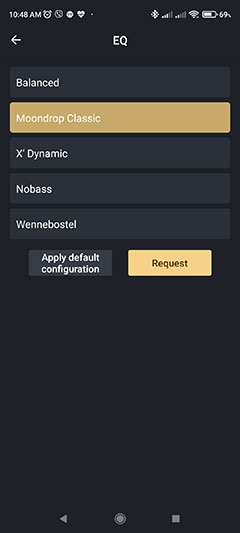
EQ Modes
While the Nekocake doesn’t really have a manual EQ system, the EQ presets that are available on the Nekocake are enough for most tastes. I ended up listening to the balanced mode for most of my listening sessions, which is based on Moondrop’s VDSF tuning that presents a generally even-handed tonal balance in my opinion.
Moondrop Classic EQ preset on the other hand is another take on the balanced tuning which makes for a more relaxed presentation. This pushes back both the treble and midbass making the vocal range more distinct.
As the name suggests, the X’Dynamic EQ preset makes the music much more dynamic by elevating the mid-bass making bass notes more palpable. However, this comes at the cost of making the bass notes bleed into the rest of the frequency spectrum.
Although the Nobass EQ preset would suggest that it would attenuate away all the bass, it reduces the airiness of the Nekocake. This is designed to mask the shortcomings of poorer recordings, however, it also ends up being a generally even-handed EQ present particularly for those who may be more sensitive to treble.
Finally, there is the Wennebostel tuning, which is based on the S-initial earphone from Germany. This tuning sounds like a mix of the X’dynamic and the Nobass tuning, giving a mid-bass boost to the Nobass EQ preset. While the bass is boosted on the Wennebostel EQ preset, the elevation is more tasteful ensuring that it doesn’t dominate the rest of the frequency spectrum.
Click on page 2 below for wireless performance and select comparisons


